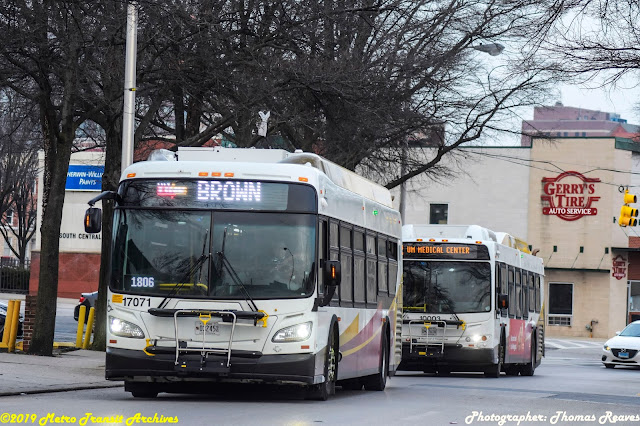The ABCs of Scheduling and Service Planning: Cycle Time
Scheduling 202
The ABCs of Scheduling and Service Planning
Cycle Time
In the previous post about headways, the term Cycle time was mentioned. It is a term so encompassing, it needed its own discussion.
Cycle Time according to MTA, is the amount of time required for a vehicle to make a round trip, including layover/recovery time at each end, used to calculate peak vehicle requirement and/or headway.
Defining what Cycle time is, can also help answer one of the most enduring questions asked by passengers: Why can't my line (insert route) run more buses?
A lot of factors goes into determining cycle time, which can determine headway or frequency. If the line has high ridership, it should run more often. If a line has low ridership, it should run less often.
There is math behind cycle time. It goes like this:
Let's say during the rush hour, it takes a line 45 minutes from one direction and 43 minutes in the other direction, it is a total of 88 minutes. If this is a high ridership route and the passenger loads say the route should run every 10 minutes, then the cycle time has to factor in the layover time so the bus can leave on time. In this instance, 90 minutes is too little, so you go 10 more minutes to 100. This gives the line 10 buses total, as the cycle time suggests. This also gives the bus 12 minutes of layover which can be split in a few ways (5/7 or 6/6) to recover.
10x9=90, which is too short. 10x10=100, which works.
So the schedule would read the bus leaves at :00, arriving at the other end by :45, departing at :51 after, and arriving on the round time at :34. On its next trip, it would depart at :40 after the hour, maintaining the prescribed 10 minute headway.
The more complicated the line, the more the cycle time produces "unusual" headways. For example, the CityLink Yellow. Since the route has two branches (UMBC and Patapsco Station), the cycle time is used to determine the headway, instead of the other way around.
As shown below during the midday, the Patapsco branch takes 83 minutes from Mondawmin Metro and 78 minutes to Mondawmin Metro. Meanwhile, the UMBC branch takes 81 minutes from Mondawmin and 83 minutes to Mondawmin. That is 161 minutes for the Patapsco branch and 164 minutes for the UMBC branch. Because the UMBC takes longer, the cycle time is longer. So the 10:26am departure from Mondawmin, arrives at UMBC around 11:47am, has a 13 minute layover, leaving at 12:00pm, and arrives at Mondawmin around 1:23pm. A round trip that lasts 2hr36mins. So it takes the bus more than 2 1/2 hours to do a round trip. The bus has a 10 minute layover before heading back to UMBC. The 10:15 departure from Mondawmin arrives at Patapsco around 11:38, has a 11 minute layover, before departing, arriving at Mondawmin 1:07pm. A round trip that lasted 2hr52mins
To ensure that the requirements of cycle time are met, the headway is spread out, so instead of a "policy" headway of every 10 minutes, some trips operate in odd numbers, from 11 minutes to 15 minutes, to sometimes 25 minutes.
The CityLink Brown, another route with branches (Overlea and White Marsh) has a less difficult cycle time, at least on Sundays.
As shown below, the Brown runs every 30 minutes on Sundays. The cycle time between Downtown & Overlea is 39 minutes outbound and 45 minutes inbound equaling 84 minutes for a round trip. Factoring in the headway, 90 minutes is not enough layover, so the next cycle is 120 minutes. This gives the bus 36 minutes of layover, which is split up as 25 minutes at Overlea and 11 minutes in Downtown. The White Marsh branch takes 61 minutes outbound and 68 minutes inbound equaling 129 minutes for a round trip. Although 150 minutes would work, to keep the headway balanced, the cycle time bumped up to 180 minutes, giving the bus and its operator 40 minutes at White Marsh Park & Ride, and 11 minutes. This gives the line six buses during the midday for service.
30x3=90-Too short
30x4=120-Fine
30x5=150-Fine
30x6=180-Fine
Now onto an easier example, the 29, which operates between Mondawmin and Brooklyn Homes. The headway during the rush hour is every 20 minutes and a cycle time of 121 minutes.
20x6=120, which is too short. 20x7=140, which fits just right. So there are seven buses on the line during rush. During the day, the headway is every 35 minutes with a cycle time of 110 minutes
35x3=105, which is too short. 35x4=140, which works. So there are four buses on the line at that time. Since it's 110 minutes round trip, the rest is layover, which is 15 minutes.
Lastly, looking at a short line like the 81, in which its Deer Park service operates every 35 minutes with a cycle time of 45 minutes.
35x1=35, which is way too short.
35x2=70, which works fine.
So there are two buses on the line with 25 minutes of recovery.
Hopefully, after this exercise, there is a better understanding why certain lines operate the amount of buses in different periods of the day.
Next up: Block numbers








Comments
Post a Comment